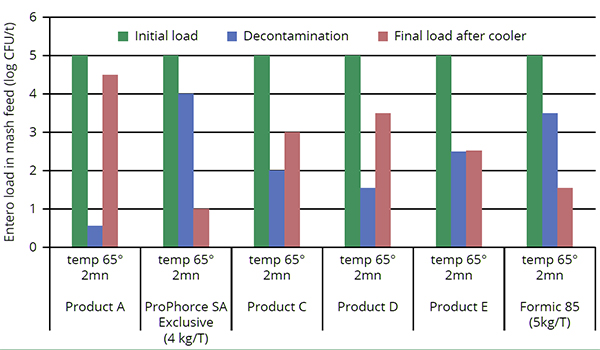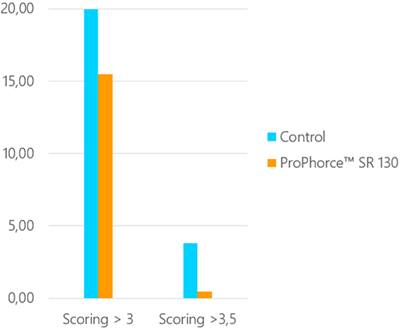Focusing on feed hygiene and gut health is two steps closer to NAE
To achieve the goal of no antibiotics ever, the industry needs to look at all areas of the production system. Optimizing management, health and nutrition, whilst reducing exposure to pathogens. Both gut health and feed hygiene are key drivers to reduce the need for antibiotics. This is where the use of targeted feed treatments and additives can help. Ensuring animals are fed safe feed means preventing contamination and reducing the risk of re-contamination. A healthy gut means healthy and optimally performing animals – this can be achieved by supporting gut function and its natural protective mechanisms.
Feed Hygiene
Controlling the risk of contamination is a difficult task as risks occur throughout the production process. These include molds (mycotoxins); oxidation of fats and oils; heavy metals; dioxins and pathogenic bacteria - such as Salmonella and E. coli. All raw materials should be checked for harmful substances and preventative measures employed.
ProPhorce™ Feed Hygiene (Perstorp) are a range of products that combine an optimized selection of organic acids and essential oils for to help maintaining optimal feed hygiene.
The effectiveness of ProPhorce™ SA Exclusive (from this product range) at reducing enterobacterial load, was compared to heat treatment alone, formic acid and four other feed hygiene solutions. The trial carried out in Tecaliman, France, measured the initial bacterial load, level after treatment and after cooling. The latter process creates condensation and the air used may be dirty; allowing mold and bacteria like E. coli to grow. Figure 1. shows that heat treatment isn’t sufficient for full protection, as it doesn’t prevent re-contamination, also demonstrating that feed hygiene solutions are not equally effective. After heat treatment at 65°C the levels of enterobacteria were still unacceptable following cooling. In contrast, a combination of heat treatment and ProPhorce™ SA Exclusive resulted in an enterobacterial reduction of more than 3 log CFU.

Figure 1: reduction of entero bacteria load in mash feed through heat treatment and consecutive recontamination prevention through feed hygiene additives. Not all additives prove equally effective.
Non-pathogenic stressors and gut health
Pressure on gut health is not only caused by pathogens in feed but also by: physiological and psychological stresses, medications, insufficient feed and imbalances in the gut microflora. These negative influences may result in a leaky gut. Increased intestinal permeability means that harmful agents can pass over the intestinal barrier and enter the blood circulation and cause systemic issues.
For healthy and productive livestock, external stressors should be reduced as much as possible. Providing high quality, clean feed and drinking water – at the same time ensuring easy access to both – will help to support gut health. Feed formulation and raw material selection can also have a significant effect on the incidence of leaky gut.
Butyric acid supplementation
The SCFA butyric acid is naturally produced in the colon during fermentation of dietary fibers. It promotes gut balance by several well researched mechanisms within the gastrointestinal tract:
• support gut development
• improve gut barrier function
• support the development of a favorable gut microbiota
• enhance feed digestibility
• support the immune system
Butyric acid has been long used as a feed additive in a coated form; due to its volatility and odor. However, the coating that protects it from degradation in the stomach takes up much of the product weight. In order to optimize the beneficial effects of butyric acid, esterifying technology has been used to create tributyrin. Butyrins are hydrolyzed after the stomach, in the small intestine, ensuring butyric acid is released and delivered where it is most effective. Butyrins are added at a lower dosage than coated products for the same results due to a higher concentration of butyric acid content. ProPhorce™ SR (Perstorp) also has benefits in terms of stability and handling for feed production.
Gut health in action
To evaluate the effect of ProPhorce™ SR 130 a trial was carried out at the University of Illinois in weaning pigs. Feces quality score was measured in pigs, fed either a commercial control ration or one containing ProPhorce™ SR 130, for five weeks. Poor feces scoring is indicative of a gut health issue – in the trial fewer pigs had scores over 3 and 3.5, when they were fed supplied with the tributyrin product (Figure 2) (Where a score of 1 was normal and 5 was liquid). When tracked over the 35 days there was a clear improvement in feces consistence in pigs fed ProPhorce™ SR 130 – particularly between day 10 and 22 – a critical period.

Figure 2: Feces scoring of weaning pigs comparing diets without tributyrin with diets including tributyrin (ProPhorce™ SR).
Clean feed and a healthy gut
With the aim of reducing the need to treat with antibiotics the focus needs to be on prevention. Reducing pathogenic pressure from feed (and water) is key and feed hygiene strategies should not only aim to reduce enterobacterial levels but also to prevent recontamination. The organic acid product studied is a highly effective tool for the promotion of feed hygiene. Whilst the benefits of butyric acid are well known, efficient dosing and delivery is essential to get results. Tributyrin is a powerful tool to deliver butyric acid and to obtain its well established benefits for gut balance. Trials have demonstrated the advantages to livestock in terms of growth and feed efficiency – all helping to reduce the need for antibiotics.